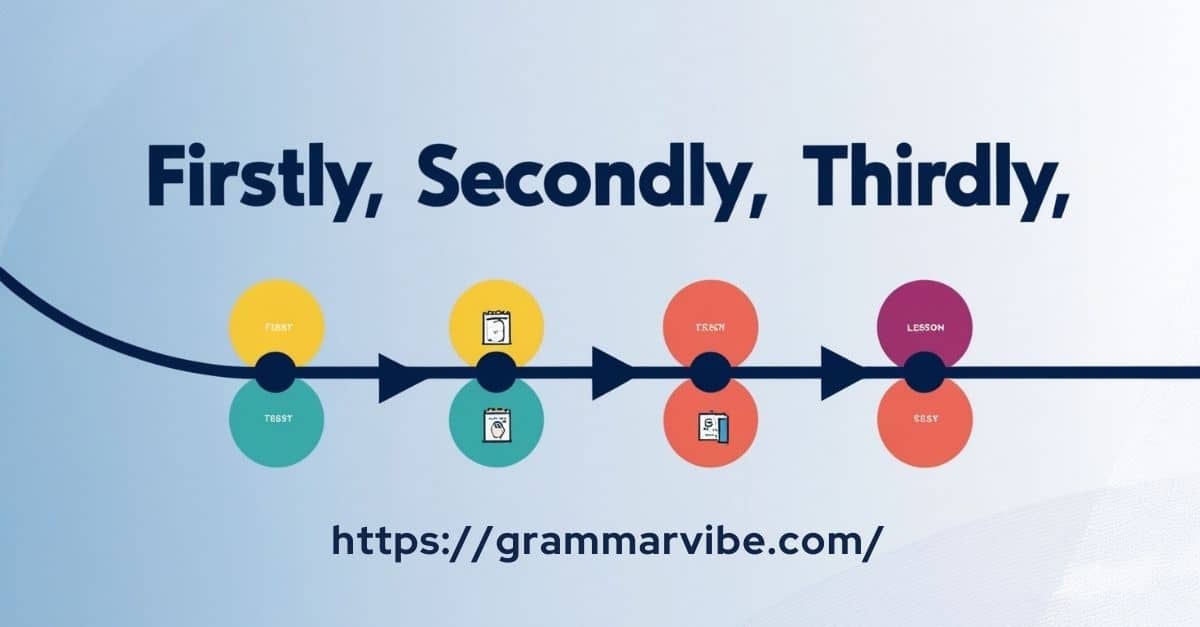In writing and presentations, using sequence and progression phrases like “Firstly, Secondly, Thirdly” helps keep ideas organized. However, overusing these words can make writing sound formulaic. There are many alternatives to ‘Firstly, Secondly, Thirdly’ that bring variety to essay structure, presentation clarity, and argument structure.
We will explore alternatives and provide scenario examples to illustrate each, giving you a versatile toolkit for keeping readers engaged.
Alternative Ways to Organize Points
Below are some effective sequencing words that can improve the flow of writing and offer different tones, from casual to formal. Each option includes examples to show how they can be used to prioritize points and build a logical sequence of ideas.
1. First, Next, Then
Using First, Next, Then is simple and familiar, perfect for maintaining a clear progression of ideas in both formal and informal contexts.
Example (Email):
Hi Samantha,
First, we need to gather all of the team’s project outlines. Next, let’s set a meeting to discuss the main objectives. Then, we can proceed with individual tasks. Let me know if you have any questions!
Best,
Michael
2. To Begin With, Furthermore, In Addition
This set adds a level of formality, making it suitable for persuasive writing or formal presentations where each point builds on the previous one.
Example (Report):
To begin with, research shows that 70% of users prefer online support. Furthermore, integrating a support chat feature could reduce operational costs. In addition, it would improve user engagement, leading to a more positive brand experience.
More for you: Other Ways to Say “Looking Forward to Working With You”
3. Initially, Subsequently, Finally
Using Initially, Subsequently, Finally provides a clear sequence of events and is especially effective in argumentative essays or presentation structures.
Example (Research Presentation):
Initially, the theory was met with some skepticism. Subsequently, after several trials, the data confirmed the hypothesis. Finally, the study concluded with promising results.
4. In the First Place, In the Second Place, In the Third Place
These phrases are great for emphasizing arguments in a formal tone, often used in academic or legal writing to separate important points distinctly.
Example (Argumentative Essay):
In the first place, this policy overlooks the needs of small businesses. In the second place, it lacks provisions for sustainable growth. In the third place, the policy contradicts current economic priorities.
You might also like: Nicholas’ or Nicholas’s
5. First of All, After That, Lastly

This sequence is informal, ideal for keeping a friendly yet organized tone in personal emails or informal presentations.
Example (Email):
Hi Chris,
First of all, thank you for organizing last week’s meeting. After that, we should focus on refining the project plan. Lastly, let’s confirm the budget so we can move forward.
Cheers,
Jenna
6. Primarily, Secondly, Lastly
This trio is useful for prioritizing points, especially in discussions where the primary focus needs to be highlighted right from the start.
Example (Proposal):
Primarily, our aim is to increase customer satisfaction. Secondly, we’ll address the feedback received. Lastly, we need to create a strategy for future customer engagement.
7. First and Foremost, Afterward, Concurrently
With a focus on importance, First and Foremost, Afterward, Concurrently is used in strategic planning or projects with simultaneous actions.
Example (Business Strategy):
First and foremost, securing project funding is our top priority. Afterward, we can focus on expanding the team. Concurrently, we’ll be reaching out to potential partners.
Check out this: Kid’s or Kids’ or Kids
8. Beginning with, Following that, Lastly
Ideal for storytelling or event descriptions, this sequence ensures order of ideas in a clear and direct way.
Example (Product Launch):
Beginning with a keynote speech, we’ll set the stage for our new product. Following that, we’ll provide live demonstrations. Lastly, we’ll open a Q&A session.
9. As a Start, Continuing with, Concluding with
Using As a Start, Continuing with, Concluding with gives a structured, professional tone, suitable for formal tone contexts.
Example (Proposal):
As a start, let’s address the immediate operational challenges. Continuing with a focus on efficiency, we’ll introduce automated workflows. Concluding with a final evaluation, we can measure overall impact.
10. The First Point Is, The Second Point Is, The Third Point Is
This straightforward approach works well in persuasive contexts where clarity and directness are needed.
Example (Debate):
The first point is that our new policy will enhance efficiency. The second point is that it will reduce costs. The third point is that it will improve team morale.
For your interest: Other Ways to Say “Thank You for Your Effort”
11. First Step, Next Step, Final Step
Perfect for instructions or guides, this sequence clearly outlines actions or phases.
Example (Instruction Guide):
The first step is to log in to your account. The next step is to choose your subscription plan. The final step is to confirm your payment.
12. Initially, Then, Ultimately

Ideal for clear progression in narratives or detailed explanations, Initially, Then, Ultimately adds a sense of conclusion.
Example (Process Description):
Initially, the product is developed based on user research. Then, it goes through rigorous testing. Ultimately, it’s released with comprehensive support materials.
13. First Consideration, Second, Third
First Consideration, Second, Third helps emphasize points based on priority, useful in strategic planning or business proposals.
Example (Strategic Plan):
Our first consideration is customer retention. Second, we aim to increase our online presence. Third, we’ll explore new markets.
14. For Starters, Also, Finally
Casual and conversational, For Starters, Also, Finally works in informal emails and everyday conversations.
Example (Email):
Hi Emma,
For starters, let’s cover the basic requirements. Also, please review last month’s feedback. Finally, let me know if you need help with any of the tasks.
Best,
Liam
15. Starting Off, Additionally, Wrapping Up
Starting Off, Additionally, Wrapping Up offers a smooth flow with a friendly tone, useful for semi-formal settings.
Example (Team Meeting Notes):
Starting off, we’ll discuss the new targets. Additionally, let’s look at upcoming projects. Wrapping up, we’ll address any remaining questions.
Table of Alternatives to “Firstly, Secondly, Thirdly”
| Alternative Set | Example Usage |
|---|---|
| First, Next, Then | Instructions, guides |
| To begin with, Furthermore, In addition | Persuasive writing |
| Initially, Subsequently, Finally | Academic essays |
| In the first place, In the second place, In the third place | Argumentative essays |
| First of all, After that, Lastly | Informal emails |
| Primarily, Secondly, Lastly | Prioritizing points |
| First and foremost, Afterward, Concurrently | Strategic planning |
| Beginning with, Following that, Lastly | Event planning |
| As a start, Continuing with, Concluding with | Business proposals |
| The first point is, The second point is, The third point is | Debates |
| First Step, Next Step, Final Step | Instructional guides |
| Initially, Then, Ultimately | Process descriptions |
| First Consideration, Second, Third | Strategic planning |
| For Starters, Also, Finally | Casual conversations |
| Starting Off, Additionally, Wrapping Up | Semi-formal meetings |
Conclusion
Incorporating these alternatives to “Firstly, Secondly, Thirdly” adds a polished and dynamic flow to your writing, making it easier for readers to absorb and engage with your points. By using varied transitions, you keep your arguments fresh and avoid the repetitive feel that numbered transitions can sometimes create.
Whether in professional reports, casual emails, or academic essays, these alternatives enable smoother progression and emphasize each idea with greater clarity. With these phrases in your toolkit, you can craft writing that’s not only organized but also impactful and accessible to your audience.

Kyren Paul is an experienced blogger and the creative mind behind “Grammar Vibe.” With a passion for the nuances of English grammar, he brings clarity and insight to everyday language topics, making grammar accessible and engaging for readers of all levels.











Leave a Comment